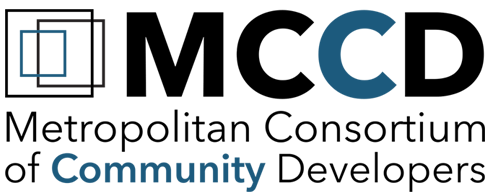Member Meeting Recap
Thoughts on Community Development
Economic Development: An Update on the Twin Cities Labor Market
By: Kelly Law, MCCD Policy & Field Building Advisor
On Wednesday, September 7th, MCCD hosted a community economic development member meeting with a specific focus on labor market conditions in the Twin Cities. MCCD was lucky enough to be joined by two guest speakers from the Community Development and Engagement team at the Federal Reserve Bank of Minneapolis: Mary Hogan, Senior Policy Analyst and Tyler Boesch, Economist and Analyst.
The Minneapolis Fed serves the public by supporting a growing economy and operates in an area known as the Ninth Federal Reserve District, which includes Minnesota, Montana, North and South Dakota, and 26 counties in northwestern Wisconsin, and the Upper Peninsula of Michigan. The Community Development and Engagement team works to advance the economic well-being of low- to moderate-income people and communities living and working in the Ninth Federal Reserve District.
During the presentation, MCCD members gained insights on the status of the labor market across the Twin Cities Metro and Minnesota. We learned employers are reporting that labor availability for open positions is the most challenging obstacle that they are facing when operating their business, indicating the tight labor market present in Minnesota and nationally.
Despite low unemployment rates and a competitive labor market, disparities in employment persist. In Minnesota, the overall unemployment rate, which is defined as the percentage of those in the labor force looking for work, has dropped to pre-pandemic levels, however, this same trend has not been felt equally by all Minnesotans. While the unemployment rate for White Minnesotans is sitting right around 2.3%, the unemployment rate for Black Minnesotans and Hispanic Minnesotans is 6% and 4%, respectively. Tyler and Mary shared explanations for why these disparities continue to exist:
- Occupational Segregation: Workers of diverse groups are not proportionally found in each occupation; rather, some occupations have larger shares of BIPOC workers than others. Certain occupations that are more vulnerable to economic shocks, like the COVID-19 pandemic, which are also more heavily concentrated with BIPOC workers are more likely to have higher levels of racial disparities in unemployment.
- Systemic Factors: Other factors, including education, housing, and criminal justice also contribute to disparities in employment. Minnesota has some of the largest gaps in educational outcomes in the country by race and ethnicity. Additionally, racist housing policies like redlining and systemic housing discrimination have heavily influenced regional patterns for BIPOC communities, including labor market patterns.
Racial discrimination also plays a notable role in creating labor market disparities. As seen in the graph above, White applicants typically had a higher callback rate than Black applicants when applying for a job in the Twin Cities. This disparity is evidenced more acutely when also accounting for factors such as having a criminal record.
The consequences of labor market disparities are significant. The Minneapolis Fed estimates that if racial gaps in the labor market were closed, the GDP, or total economic output, in Minnesota would have increased by $6.6 billion from 2005 to 2019. As Tyler and Mary both stated, when individuals are fully able to participate in the labor market, the economy benefits.
To conclude the presentation, Mary shared potential avenues for rectifying labor market disparities that the Minneapolis Fed is specifically focused on:
- Ban non-compete agreements, which limit workers’ employment opportunities.
- Remove occupational licensing requirements that are not needed to ensure public safety as BIPOC workers are less likely to be licensed than White workers. This matters as licensed workers tend to receive higher wages and more secure employment than unlicensed workers.
- Establish or expand short-time compensation (STC) programs to prevent layoffs, as well as expand unemployment insurance eligibility.
Below are some links to additional materials and resources shared by Mary during the meeting:
- “Occupational Licensing Can Limit Employment Options for Immigrants”
- “How Occupational Licensing Limits Access to Jobs Among Workers of Color”
- “Noncompete Contracts Sideline Low-Wage Workers”
- “What Did and Didn’t Work in Unemployment Insurance During the Pandemic”
MCCD is grateful to Tyler, Mary, and our members for sharing their time with us, and we look forward to continued efforts to ensure equitable access to the labor market for all Minnesotans.

